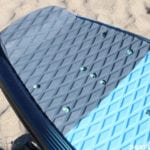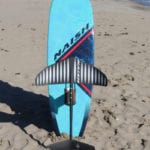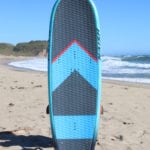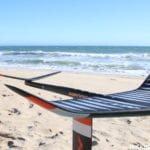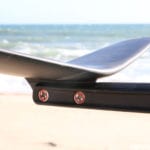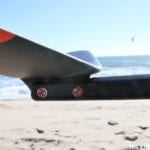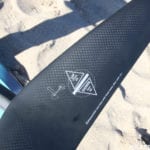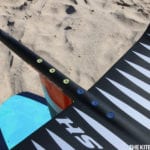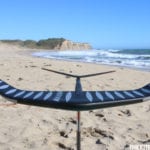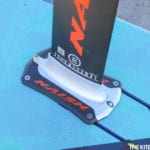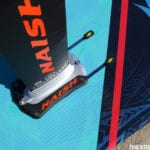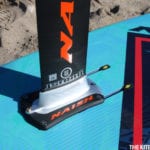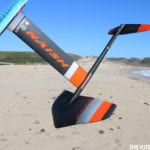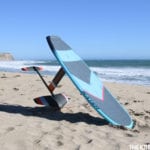NAISH Thrust Surf Foil
Mast Sizes Available: 55cm (Naish makes a 90cm for the Thrust package)
Mast Sizes Tested: 55cm
Naish Says:
Designed in collaboration with Kai Lenny, the Thrust Surf Hydrofoil develops lift at low speed and launches with minimal effort””a huge advantage for those getting started in kitefoiling. The combination of early take-off and excellent maneuverability makes it great for waveriding, cruising and racing. The extra long fuselage creates a large sweet spot and provides stability, while the downturned stabilizer (rear foil) makes waveriding and turning intuitive and easy. The small (55 cm) extruded alloy mast can be retrofitted to any style box system. Whether surfing, kiting or downwinding, the Thrust Surf Foil will keep you stoked session after session!
Visit for more info: www.naishkites.com/product/thrust-surf-foil/
Tkb Says:
We got the chance to ride the 2019 Naish Thrust Surf Foil well ahead of its release and loved the changes made for this year. Naish has revamped the fuselage design, connection points and made the whole setup cleaner and seemingly stronger. When it comes to putting the foil together, the Naish team made assembly quite easy with the entire assembly happening with a single Philips screwdriver. This year the new fuselage design feels a little bit more crisp and stiff. The tail unit continues to have the option to change the angle of attack (lift) and seems to have a more solid connection with well-designed/heftier parts. When you go to assemble the wings and fuselage all of the screws have different colored painted heads which helps you decipher which screws go where, particularly when you’re hot to trot and ready to jump in the water. This year Naish has designed a new mast base system called the Abracadabra. A lot of people have to separate their mast from their board at the end of their session to fit it in their car. This can be time consuming when you’re dealing with a track system and lots of bolts/inserts that like to move around and get lost. When you have to completely unscrew all of the screws it takes a bit more work so Naish has made a setup where you just have to de-tension all your screws and you have one set screw that allows the whole mast base to slide out while the rest of the base can stay with your board. This helps quite a bit with avoiding the dreaded loss of a single screw (Editor’s Note: While not recommended, we can’t count how many times we’ve kite foiled with only three of four mast plate bolts). This setup requires less screwdriver work and gets you on the water a little bit faster.
Overall the foil’s tail design, much like last year, features an adjustment for changing the angle of the tail stabilizer; there’s a very helpful graphic printed on the top of the stabilizer which allows you to choose between neutral, high lift and low lift and tells you how to dial in the tail for more lift or less lift. When it comes to construction, everything with this wing is really solid. You’ve got an aluminum mast, aluminum fuselage, and carbon fiber wings to balance out the weight. The first thing we noticed is that none of the wing’s edges are too sharp or aggressive. When it comes to carrying the Thrust Surf Foil, we really liked the foil’s weight, but since it was paired with the relatively large, entry level 160cm Hover Board, the overall weight ticked on the heavy side. In terms of waterstarting it was pretty easy to get this setup on edge because the mast floated long enough for us to get our feet in place and power up the kite (we rode it strapless). Waterstarts were noticeably easy with this mast and in terms of foil-up speed, we found this wing to be middle of the pack within the category of slow surf foils. This wing is not quite as large as some of the big wings in our test, so it wasn’t the slowest in the surf category, but overall, the Thrust worked extremely well for carving and gives the rider the ability to go slow enough to carve and surf but also has a high-end that puts you a little closer to freeride. The Thrust Surf Foil offers a nice crossover between a surf/carving wing and freeride cruising and this allows you to both surf and cover some distance. When it comes to input and response we found this foil to be fairly equal among the three axes. The side to side yaw and up and down pitch axis feel really well balanced so the Thrust has a nice middle of the road feel that is not aggressive but still allows you to really rail on it for aggressive but controlled carving. Overall, the general consensus is that this wing is reactive without being scary. The 55m is probably a good length for surfing waves, which keeps you relative close to the surface and keeps your wipeouts on the safer side.
While this isn’t the first time we’ve tested the 160cm Hover board, we’ve found it’s generally a very user-friendly board that is ideal for entry level kiters with a longer length that is fairly forgiving. With a good amount of volume the board helps with waterstarts and its nose rocker seems to work well keeping everything under control during unintended touchdowns. While this board is an excellent entry-level, beginner to intermediate board, it is a little bit heavier because of its size. More advanced foilers may choose to pare down to the smaller more performance-oriented boards in Naish’s Hover line.
Overall the Thrust Surf Foil is a really user-friendly piece of equipment that demonstrates refinement in design and construction with an easy and straight forward setup. The performance on this wing crosses both into the carve and surf category as well as the freeride cruising category. It’s got potential as an entry-level wing that goes slow enough to get started but nimble enough to match your progression through to more aggressive riding.





